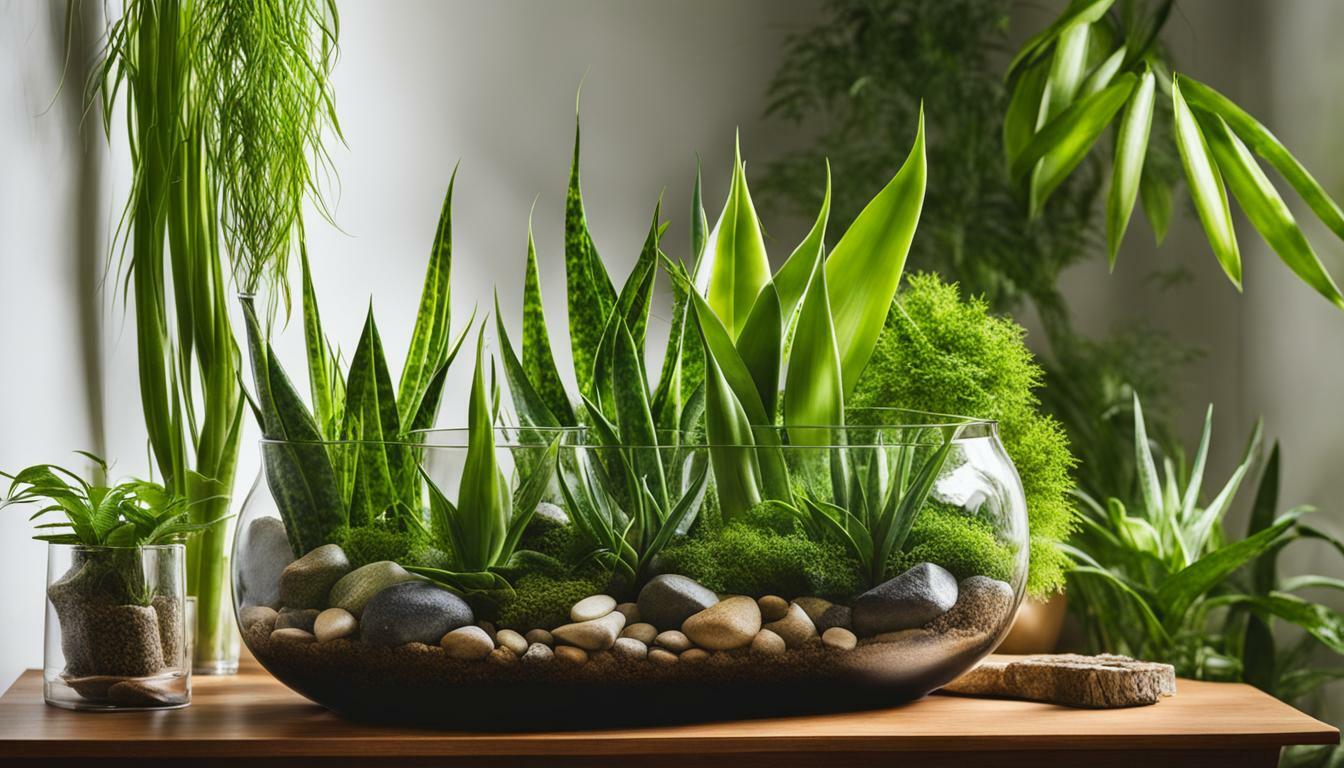Terrarium plants offer a unique way to bring nature indoors, and snake plants, with their diverse varieties and easy care requirements, are an excellent choice for plant enthusiasts.
When it comes to terrarium plants, there are many options to choose from depending on whether you have an open or closed terrarium. Closed terrariums are best for tropical plants that thrive in high humidity, such as miniature ferns, tropical vines, and orchids. Open terrariums, on the other hand, are suitable for arid species that prefer low moisture and good airflow, like succulents and cacti. Snake plants, also known as Sansevierias, are a popular choice for open terrariums as they are low maintenance, can tolerate low light, and have interesting textures. Other recommended plants for open terrariums include haworthia, echeveria, burro’s tail, pothos, and jade plants. For closed terrariums, plants that thrive in warm, high humidity environments, like phalaenopsis orchids, bird’s nest ferns, aloe, and calathea, are recommended.
Key Takeaways:
- Terrarium plants provide an indoor nature experience.
- Snake plants are an excellent choice for open terrariums.
- Closed terrariums are ideal for tropical plants that thrive in high humidity.
- Other recommended plants for open terrariums include haworthia, echeveria, burro’s tail, pothos, and jade plants.
- For closed terrariums, consider plants such as phalaenopsis orchids, bird’s nest ferns, aloe, and calathea.
Choosing the Right Terrarium for Snake Plants
Creating an ideal environment for your snake plants starts with choosing the right terrarium that suits their low-maintenance requirements and provides optimal conditions for their growth. When it comes to terrarium plants, there are two main types to consider: open terrariums and closed terrariums. Each type has its unique characteristics and is suitable for different plant species.
Open terrariums are perfect for snake plants as they prefer low moisture and good airflow. These terrariums have an opening or lack a lid, allowing fresh air to circulate freely. Snake plants, also known as Sansevierias, thrive in open terrariums due to their ability to tolerate low light conditions and their interesting textures. Other recommended plants for open terrariums include haworthia, echeveria, burro’s tail, pothos, and jade plants. This combination of plants creates a visually appealing display with varying shapes and colors.
Closed terrariums, on the other hand, provide a more controlled environment with high humidity. They are suitable for tropical plants that thrive in warm, humid conditions. If you prefer a closed terrarium for your snake plants, consider adding plants like phalaenopsis orchids, bird’s nest ferns, aloe, and calathea. These plants will flourish in the warm and moist environment created within the closed terrarium, adding lush greenery and a touch of elegance to your space.
| Terrarium Type | Recommended Plants |
|---|---|
| Open Terrarium |
|
| Closed Terrarium |
|
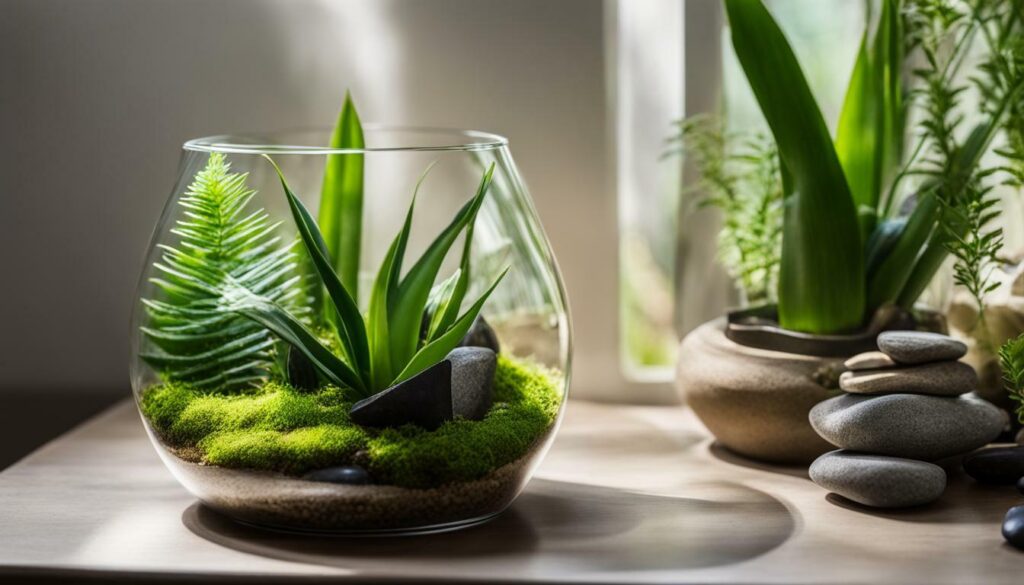
When choosing a terrarium for snake plants, consider the size, material, and design that best suits your space and aesthetic preferences. Ensure that the terrarium provides adequate drainage to prevent root rot and maintain the right moisture levels for the plants.
Remember, the key to successful terrarium gardening lies in creating the perfect environment for your snake plants. Whether you opt for an open or closed terrarium, selecting the right terrarium plants that thrive in those conditions is crucial. With a well-chosen terrarium and proper care, your snake plants will flourish and bring joy to your indoor spaces.
Snake Plant Care Tips for Thriving Plants
To ensure your snake plants thrive in their terrarium, it’s crucial to understand their care needs,from watering and lighting to propagation techniques for expanding your plant collection. Snake plants, also known as Sansevierias, are low maintenance plants that can tolerate a wide range of conditions, making them ideal for both beginners and experienced plant enthusiasts.
Watering: Snake plants prefer to be slightly on the drier side, so it’s important not to overwater them. Allow the soil to dry out between waterings, and then water thoroughly, allowing any excess water to drain away. Be sure to avoid water accumulation in the bottom of the terrarium, as this can lead to root rot.
Lighting: While snake plants can tolerate low light conditions, they thrive best in bright, indirect light. Place your terrarium near a window that gets indirect sunlight or provide artificial lighting if needed. Avoid exposing the plants to direct sunlight, as this can cause leaf burn.
Propagation Techniques: Snake plants can be easily propagated through division or leaf cuttings. To divide your snake plant, carefully remove the plant from its container and gently separate the rhizomes, making sure each division has roots. Alternatively, you can take a healthy leaf cutting and allow it to callus for a few days before placing it in well-draining soil. Keep the soil slightly moist until roots develop. Propagation is a great way to expand your snake plant collection or share plants with friends.
| Care Needs | Watering | Lighting | Propagation Techniques |
|---|---|---|---|
| Snake Plants | Allow soil to dry out between waterings | Bright, indirect light | Division or leaf cuttings |
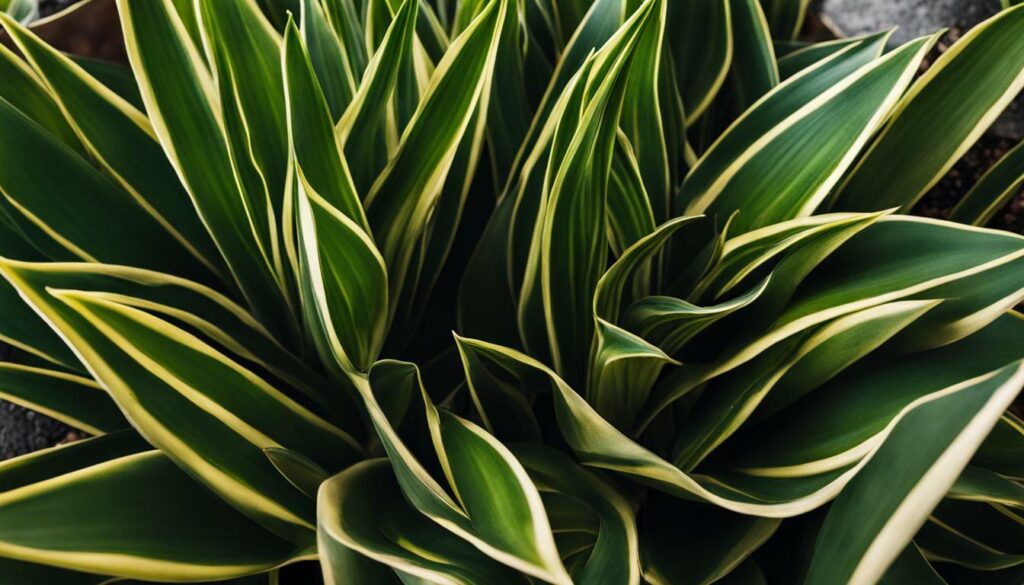
By following these care tips, you can ensure your snake plants thrive in their terrarium. Remember to monitor the soil moisture, provide adequate lighting, and explore propagation techniques to expand your plant collection. Snake plants are versatile and resilient, making them an excellent addition to any terrarium.
Key Care Tips for Snake Plants:
- Allow soil to dry out between waterings to prevent root rot.
- Place your terrarium in bright, indirect light to promote optimal growth.
- Propagate your snake plants through division or leaf cuttings for expansion.
Snake Plant Varieties for Diverse Spaces
Snake plants come in a variety of stunning options, each with its own distinct features and growth patterns, making them versatile choices for different indoor terrarium setups. Whether you prefer tall and upright plants or compact varieties that spread out, there is a snake plant to suit every preference.
| Variety | Description | Key Features |
|---|---|---|
| Mother-in-law’s Tongue (Sansevieria trifasciata) | A classic snake plant with long, upright leaves featuring dark green coloration and yellow variegation. | Drought-tolerant, air-purifying, and adaptable to various lighting conditions. |
| Black Gold (Sansevieria trifasciata ‘Black Gold’) | A compact snake plant with dark green leaves and golden-yellow vertical stripes. | Low maintenance, ideal for small spaces, and adds a pop of color to terrarium displays. |
| Futura Robusta (Sansevieria cylindrica ‘Futura Robusta’) | A unique snake plant with cylindrical, spear-like leaves arranged in a fan shape. | Architectural appeal, drought-tolerant, and adds visual interest to terrarium arrangements. |
These are just a few examples of the many snake plant varieties available for indoor terrariums. When choosing a snake plant for your terrarium, consider the lighting conditions, space available, and the desired visual impact. Keep in mind that snake plants, in general, are excellent air purifiers, making them a practical and aesthetically pleasing addition to any indoor environment.
Snake plants are known for their ability to remove toxins from the air, making them perfect companions for indoor spaces. Their unique growth patterns and vibrant colors add a touch of greenery and elegance to any terrarium.
Remember to choose the right potting mix, provide adequate drainage, and water your snake plants sparingly to prevent root rot. With proper care and attention, your snake plants will thrive in their indoor terrarium habitats.
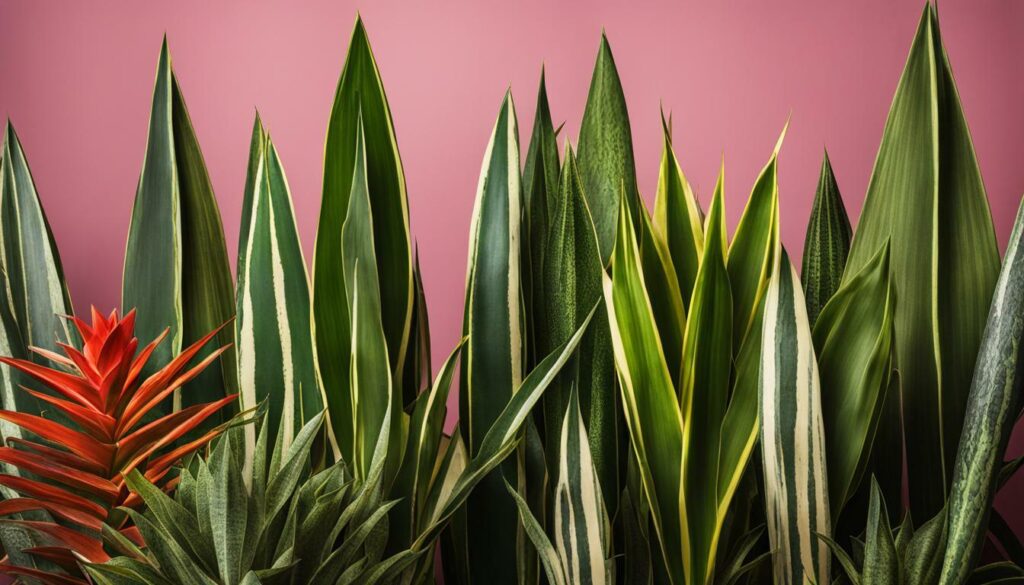
When planning an open terrarium, incorporating low maintenance plants alongside snake plants can create a beautiful and hassle-free display. Snake plants, also known as Sansevierias, are a popular choice for open terrariums as they require minimal care and can thrive in various light conditions. Their unique texture and striking appearance add visual interest to any terrarium.
Alongside snake plants, there are several other low maintenance options that can complement their growth requirements. One of these options is haworthia, a succulent plant with fascinating rosette-shaped leaves. Haworthias are known for their ability to tolerate low light and minimal watering, making them an excellent companion for snake plants in an open terrarium. Another suitable choice is echeveria, a type of succulent that features stunning rosettes in an array of colors. Echeverias are highly adaptable and can tolerate dry conditions, making them ideal for a low maintenance terrarium.
For those looking to add trailing plants to their open terrarium, the burro’s tail (Sedum morganianum) is a great option. This succulent has long, trailing stems adorned with plump, tear-shaped leaves. It thrives in bright light and requires minimal watering, making it a perfect choice for the lower levels of an open terrarium. Pothos (Epipremnum aureum) and jade plants (Crassula ovata) are also recommended as low maintenance options for open terrariums, as they can tolerate a wide range of environmental conditions, including low light and irregular watering.
Creating a visually appealing and easy-to-care-for terrarium is achievable by carefully selecting a combination of snake plants and other low maintenance plants. Their contrasting textures and growth habits will add depth and visual interest to your terrarium, while requiring minimal effort to maintain.
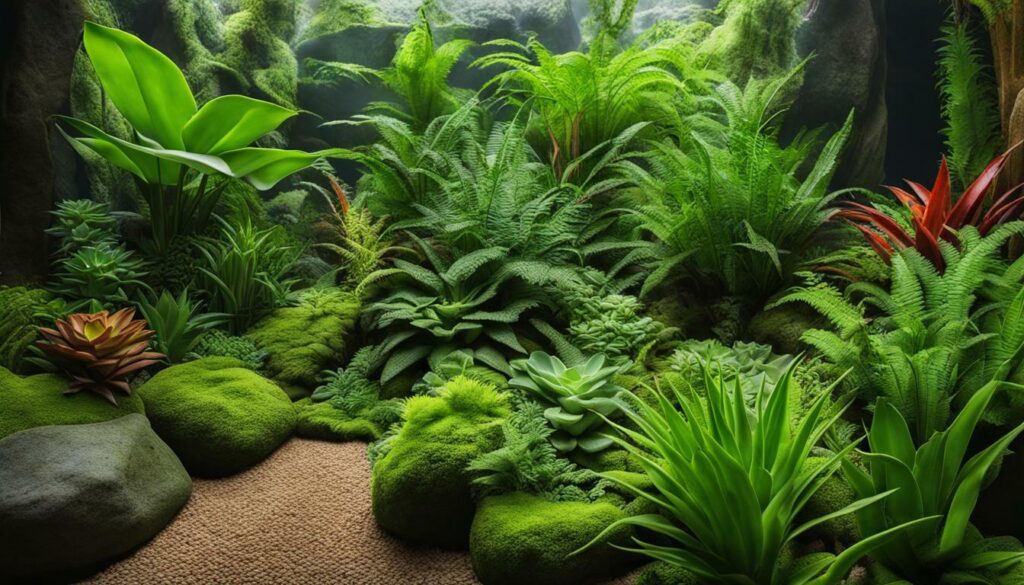
| Plant | Description | Light Requirements | Watering Needs |
|---|---|---|---|
| Snake plant (Sansevieria) | Low maintenance, striking appearance, can tolerate low light | Low to moderate | Low |
| Haworthia | Succulent with rosette-shaped leaves | Low to moderate | Low |
| Echeveria | Succulent with colorful rosettes | High | Low to moderate |
| Burro’s tail (Sedum morganianum) | Trailing succulent with tear-shaped leaves | High | Low |
| Pothos (Epipremnum aureum) | Trailing vine with heart-shaped leaves | Low to moderate | Low to moderate |
| Jade plant (Crassula ovata) | Succulent with fleshy leaves | Low to moderate | Low to moderate |
Suitable Plants for Closed Terrariums
Closed terrariums provide an excellent opportunity to cultivate lush and vibrant indoor gardens, and incorporating plants like phalaenopsis orchids and bird’s nest ferns can create a visually stunning display. These plants thrive in warm, high humidity environments, making them ideal choices for closed terrarium setups.
Phalaenopsis Orchids: Known for their elegant and colorful blooms, phalaenopsis orchids add a touch of sophistication to any closed terrarium. These tropical orchids require indirect light and consistent moisture to thrive. Their graceful arching stems and vibrant flowers create a breathtaking centerpiece in a closed terrarium.
Bird’s Nest Ferns: With their unique, feathery fronds that resemble a bird’s nest, these ferns are a popular choice for closed terrariums. They prefer bright, indirect light and thrive in high humidity environments. The lush foliage of bird’s nest ferns adds a touch of natural beauty and creates a lush and tropical atmosphere within a closed terrarium.
| Plant | Light Requirements | Humidity Preferences |
|---|---|---|
| Phalaenopsis Orchids | Indirect light | High humidity |
| Bird’s Nest Ferns | Bright, indirect light | High humidity |
These plants not only add visual interest but also help create a balanced ecosystem within the closed terrarium. Their ability to absorb excess moisture and release oxygen makes them excellent choices for maintaining a healthy and thriving terrarium environment.
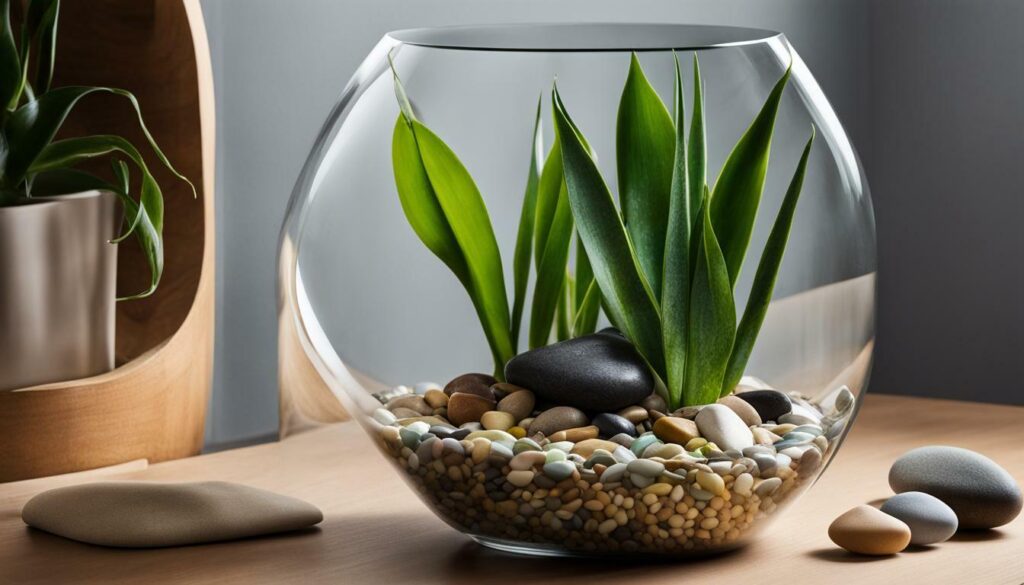
When designing your closed terrarium, remember to create a suitable microclimate by using airtight containers or glass bowls to retain moisture. Ensure proper ventilation by opening the lid occasionally to prevent fungal growth. With the right plants and maintenance, a closed terrarium can be an eye-catching addition to your indoor space, bringing a touch of nature into your home.
Snake Plants as Vivarium Plants
Snake plants not only make beautiful additions to terrariums but are also well-suited for reptile vivariums due to their low maintenance nature and suitability as climbing surfaces. These hardy plants, known scientifically as Sansevierias, can thrive in a wide range of conditions, making them an excellent choice for both beginners and experienced reptile enthusiasts.
When it comes to setting up a vivarium for your reptile, snake plants offer numerous benefits. They are known for their ability to tolerate a variety of light conditions, ranging from bright indirect light to low light, making them adaptable to different vivarium setups. Snake plants also require minimal watering, as they can withstand periods of drought, which is ideal for maintaining the humidity levels required in reptile enclosures.
“Snake plants are a great addition to vivariums as they provide a natural climbing surface for reptiles,” says reptile expert Dr. Emily Cooper.
In addition to their low maintenance nature, snake plants offer a visually appealing element to vivariums. With their tall, upright leaves and striking patterns, they add a touch of greenery and texture to the enclosure. Snake plants are also known for their air-purifying properties, releasing oxygen and filtering out toxins from the air. This can contribute to creating a healthier environment for both reptiles and their owners.
Snake Plant Care Tips for Vivariums
When incorporating snake plants into a vivarium setup, it’s important to keep a few care tips in mind to ensure their optimal growth:
- Provide a well-draining substrate to prevent over-watering and root rot.
- Maintain appropriate humidity levels for the specific reptile species housed in the vivarium.
- Place the snake plant in a location that provides adequate light based on the reptile’s requirements.
- Monitor the temperature inside the vivarium, ensuring it falls within the suitable range for both the reptile and the snake plant.
- Prune the snake plant by cutting the top of each leaf to maintain a desired size and shape.
By following these care tips, you can enjoy the beauty and benefits of snake plants in your vivarium while ensuring the overall well-being of your reptile.
| Snake Plant Care Tips for Vivariums | Snake Plant Varieties for Vivariums |
|---|---|
| Provide well-draining substrate | Sansevieria trifasciata ‘Laurentii’ |
| Maintain appropriate humidity levels | Sansevieria cylindrica |
| Place in suitable light conditions | Sansevieria masoniana ‘Whale Fin’ |
| Monitor temperature within vivarium | Sansevieria zeylanica |
| Prune for desired size and shape | Sansevieria trifasciata ‘Moonshine’ |
Snake plants offer a versatile and visually appealing option for both terrariums and vivariums. Their low maintenance nature, suitability as climbing surfaces, and air-purifying properties make them an excellent choice for reptile enthusiasts. By following proper care guidelines, snake plants can thrive in a vivarium, creating a beautiful and enriching environment for both reptiles and their caretakers.
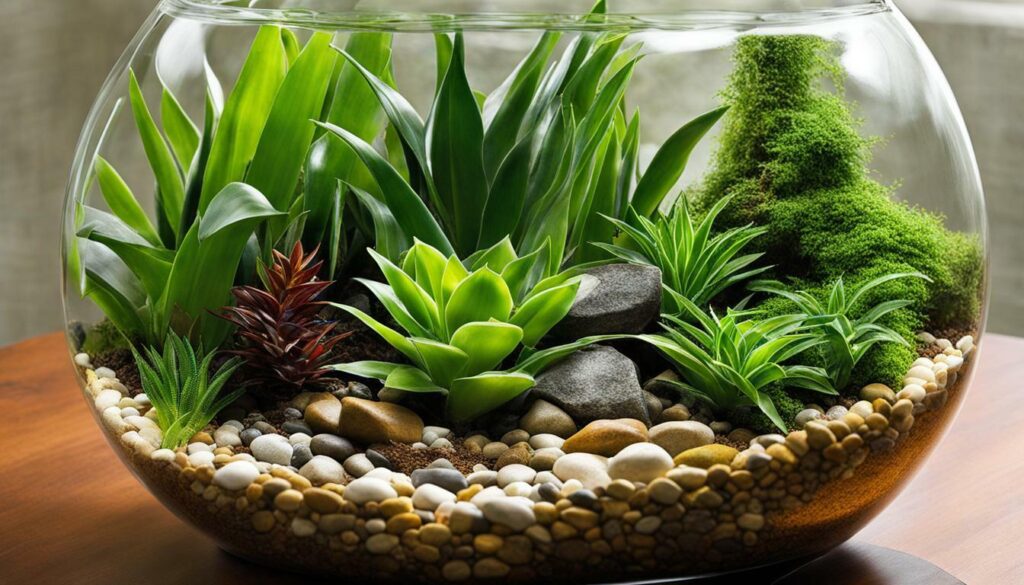
Regular maintenance, including proper pruning and propagation, is essential to keep your snake plants thriving and looking their best. Pruning helps to remove any dead or damaged leaves and encourages new growth. It also helps to maintain the desired shape and size of your snake plant.
When pruning your snake plant, use clean and sharp pruning shears or scissors. Start by identifying any yellow or brown leaves, as these are usually signs of damage or disease. Cut these leaves at the base, as close to the soil as possible. If you notice any leaves that are excessively long or have lost their upright growth habit, you can trim them back to a more desirable length. Make sure to make clean cuts, as jagged edges can lead to further damage or infections.
Propagation is another important aspect of snake plant care. It allows you to create new plants from existing ones, and also helps to rejuvenate older, leggy plants. One common method of propagation is by dividing the plant. Carefully remove the snake plant from its pot and separate the root system into smaller sections, each with its own set of leaves. Plant these sections in separate pots and provide them with the same care as the parent plant.
| Pruning Tips | Propagation Tips |
|---|---|
| Use clean and sharp pruning shears or scissors. | Divide the root system into smaller sections. |
| Remove any yellow or brown leaves. | Plant the sections in separate pots. |
| Trim back excessively long or damaged leaves. | Provide the new plants with proper care. |
Remember to provide your snake plants with the right conditions for growth. They prefer well-draining soil and moderate to bright indirect light. Water your snake plant when the top inch of soil feels dry and avoid overwatering, as this can lead to root rot. Snake plants are known for their ability to tolerate low light conditions, making them suitable for different spaces in your home or office.
By following these pruning and maintenance tips, you can ensure that your snake plants remain healthy and vibrant. Keep in mind that each plant may have specific care requirements, so it’s essential to observe and adjust your maintenance routine accordingly. With proper care, your snake plants will continue to thrive and add beauty to your indoor space.
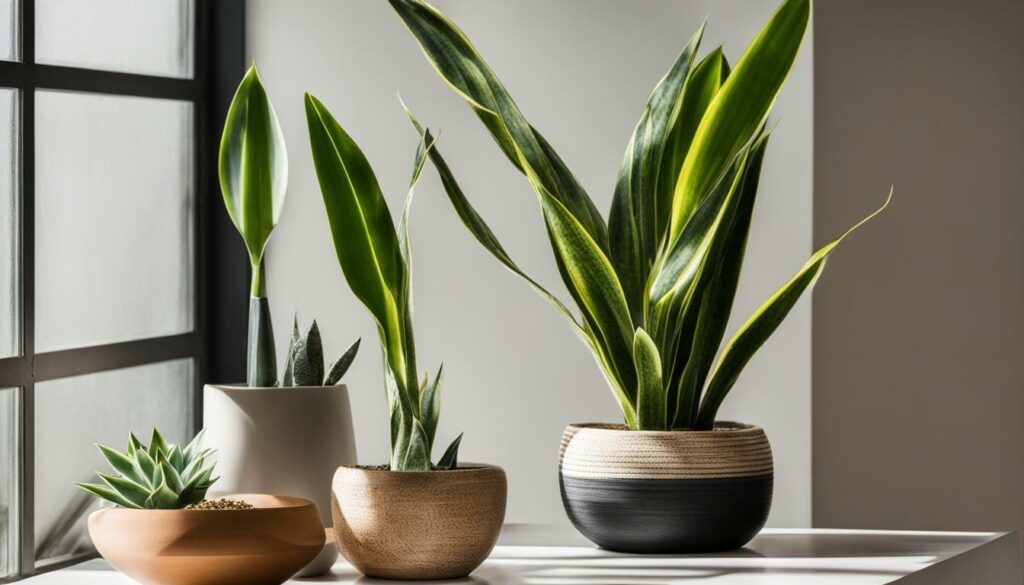
Snake plants, with their low maintenance requirements and versatility, are the perfect choice for terrarium enthusiasts looking to create thriving indoor gardens in a variety of spaces. Whether you have an open or closed terrarium, these resilient plants can adapt to different environments, making them a popular option for both beginners and experienced plant lovers.
In open terrariums, snake plants thrive alongside other low maintenance species like haworthia, echeveria, burro’s tail, pothos, and jade plants. With their ability to tolerate low light and low moisture conditions, snake plants add visual interest with their unique textures and architectural foliage.
For closed terrariums that require warm and high humidity environments, snake plants may not be the best choice. Instead, consider adding plants like phalaenopsis orchids, bird’s nest ferns, aloe, and calathea. These tropical species will thrive in the sealed conditions and provide a lush, verdant display.
When it comes to vivariums, snake plants are a suitable option for medium and large geckos. Their sturdy leaves can support the weight of the animal, and their upright growth habit provides climbing surfaces. Additionally, snake plants require minimal pruning and can be easily maintained in a vivarium setting.
With their numerous benefits and adaptable nature, snake plants are an excellent choice for creating captivating terrarium displays. Whether you’re a terrarium enthusiast or a reptile vivarium owner, these plants will undoubtedly thrive and enhance the beauty of any indoor space.
Can Snake Plants and Carnivorous Plants Thrive Together in the Same Terrarium?
Yes, snake plants and carnivorous plants can thrive together in the same terrarium. The key is to provide the right growing conditions for both. While snake plants need well-draining soil and minimal watering, carnivorous terrarium plants focus on high humidity and ample sunlight. With proper care, they can coexist beautifully.
FAQ
What types of plants are best for open terrariums?
Open terrariums are best suited for arid species that prefer low moisture and good airflow. Some suitable plants include succulents, cacti, snake plants, haworthia, echeveria, burro’s tail, pothos, and jade plants.
Which plants thrive in closed terrariums?
Closed terrariums are ideal for plants that thrive in warm, high humidity environments. Some recommended plants include phalaenopsis orchids, bird’s nest ferns, aloe, and calathea.
Are snake plants suitable for open terrariums?
Yes, snake plants, also known as Sansevierias, are a popular choice for open terrariums. They are low maintenance, can tolerate low light, and have interesting textures.
Can snake plants be used in vivariums?
Yes, snake plants are considered suitable for medium and large geckos in vivariums. They provide climbing surfaces and can support the weight of the animal. Snake plants are also easy to maintain in a vivarium setting and can be pruned by cutting the top of each leaf.
How do I prune and maintain snake plants?
Pruning snake plants is simple – just cut the top of each leaf. To maintain them, provide adequate lighting, water sparingly, and avoid overwatering. They can tolerate low-light conditions and are generally low maintenance.

